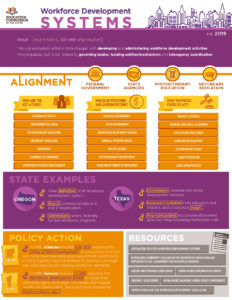As states assess their workforce needs and opportunities for further economic development, workforce boards commonly go beyond the 12 required functions set out in the Workforce Innovation and Opportunity Act (WIOA). (We highlight some of those required functions here.) States go beyond these requirements by aligning with governors’ workforce development priorities and initiatives and setting out missions and state plans for workforce development activities. While this process looks different in every state, the following state examples highlight unique approaches to workforce board missions and charges.
In an effort to link workforce activities with the state’s attainment goal, Maine’s State Workforce Board monitors workforce agency and statewide goals, making recommendations to improve the effectiveness of the workforce system. The board specifically ensures a balance between rural and urban workforce development and supports monitoring the postsecondary and credential attainment goal.
In Minnesota, the mission of the Governor’s Workforce Development Board sets out to analyze and recommend workforce development policies — relating to talent development, resource alignment and system effectiveness — to ensure the state has a workforce that is globally competitive. The board oversees priorities and initiatives, including a strategic plan; career pathways; executive initiatives; racial equity in education, training and employment committee; and WIOA. The board outlines a vision to ensure public, private and community resources are strategically aligned to competitively position people and businesses in the state for increased and sustained economic prosperity.
The Vermont Workforce Development Board advises the governor and commissioner of labor on the development and implementation of a comprehensive, coordinated and responsive workforce education and training system. A core duty requires the board to gather feedback and information about the education and training needs of employers, workers and job seekers statewide. In 2018, H. 919 directed the board to collaborate with state agencies to align, coordinate and engage workforce stakeholders. This collaboration resulted in an implementation plan incorporating key stakeholders in workforce activities across the state.
The Wisconsin Governor’s Council on Workforce Investment aligns the state’s workforce and talent development initiatives and investments through its economic development strategies. In the interest of moving the state’s economy forward, the board aids employers in finding workers they need, as well as providing resources for workers to access training for in-demand careers. The council developed the 2018-2020 Strategic Plan to ensure careers with high market value and in-demand skill sets are filled with the most qualified individuals, providing the state with a competitive advantage to attract and retain business and talent.
Through the efforts outlined here, states are not only meeting federal mandates under WIOA, but also adapting initiatives and outreach to best meet the economic development demands in their state. It proves economically advantageous for workforce boards to expand their purview to include coordinating statewide initiatives, incorporating data into future workforce planning and aligning key stakeholders behind multiple state-level goals.
Which brings us to our third and final topic, asking the question: What motivates states to act on workforce development, and how can they align efforts and activities to fulfill their given charge? Our next post explores that.
















